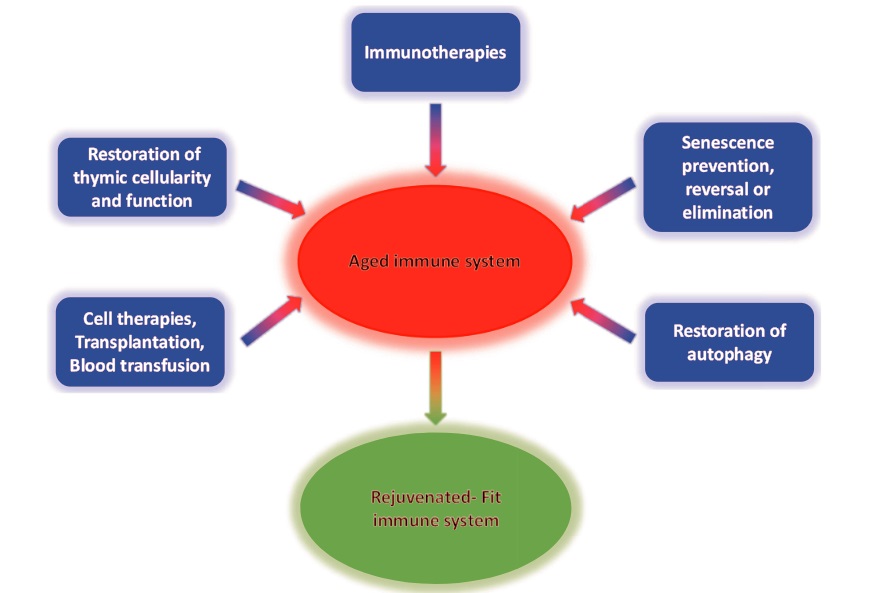Nikhil Prasad Fact checked by:Thailand Medical News Team Jan 18, 2025 2 months, 3 weeks, 5 days, 6 hours, 4 minutes ago
Medical News: The immune system serves as the body’s primary defense against infections, cancers, and autoimmune disorders. With age, this intricate network often experiences a decline, making the body more vulnerable to illnesses and less responsive to vaccines. The thymus, a critical organ for the development of T cells, plays a pivotal role in maintaining immune health. However, as people age, the thymus undergoes a process known as involution, which hampers its ability to produce new T cells. Researchers have been exploring strategies to rejuvenate the immune system, and a recent breakthrough study offers a promising solution.
 Strategies toward immune system rejuvenation.
Key Findings of the Study
Strategies toward immune system rejuvenation.
Key Findings of the Study
A study led by researchers from institutions such as the National and Kapodistrian University of Athens-Greece, the University of Dundee-UK, the Biomedical Research Foundation of the Academy of Athens-Greece, and the University of Manchester-UK, sheds light on the critical role of the receptor activator of nuclear factor-kappa B (RANK) and its ligand, RANKL. This
Medical News report delves into how the RANK-RANKL axis influences the thymus and highlights the potential of RANKL administration as a therapeutic strategy to enhance immune function.
The study reveals that as the thymus ages, there is a significant reduction in RANKL levels within thymocytes. These cells, which include gamma delta (γδ) T cells, lymphoid tissue inducer cells (LTis), early T-cell progenitors (ETPs), and CD4+ single positive cells (SPs), play an essential role in maintaining the health of thymic epithelial cells (TECs) and endothelial cells (ECs). A decrease in RANKL disrupts this balance, leading to thymic involution and compromised immune responses. By administering exogenous RANKL to aged mice, researchers successfully restored the architecture of the thymus, increased the abundance of TECs and ECs, and improved their functional properties.
Mechanisms Behind the Decline
The decline in RANKL levels during aging can be attributed to several factors. Aging is associated with the accumulation of DNA damage and epigenetic changes that affect gene expression. These changes include modifications in histones, such as decreased methylation at specific sites (H3K27me3 and H3K9me3) and increased acetylation (H4K16ac). Additionally, the production of IGF-1, a hormone that regulates RANKL levels, diminishes with age. Cellular senescence also plays a role, as senescent T cells exhibit impaired T-cell receptor (TCR) signaling, further reducing RANKL expression.
How RANKL Administration Works
The administration of RANKL in aged mice led to remarkable outcomes. It stimulated the proliferation and maturation of TECs and ECs, key components of the thymic mic
roenvironment. This process enhanced the homing of T-cell progenitors to the thymus and increased T-cell production. As a result, peripheral T-cell renewal improved, leading to more effective immune responses against tumors and pathogens. These findings were also replicated in human thymic organ cultures, suggesting the potential applicability of this approach in clinical settings.
Broader Implications and Future Directions
The study highlights the broader significance of the thymus in immune system rejuvenation. The thymus’s role extends beyond T-cell production; it is also crucial for maintaining self-tolerance and preventing autoimmune reactions. Strategies to rejuvenate the thymus could have far-reaching implications for treating age-related diseases, enhancing vaccine efficacy, and improving overall health outcomes in the elderly.
Apart from RANKL administration, other approaches to rejuvenating the immune system include the use of transcription factors like FOXN1 and BMP4 to stimulate TEC regeneration, autophagy activation through dietary interventions, and targeted elimination of senescent immune cells using senolytics. These methods aim to restore the immune system’s ability to respond to infections and maintain homeostasis.
Conclusion
The findings of this study underscore the transformative potential of targeting the RANK-RANKL axis to rejuvenate the thymus and enhance immune function. By addressing the underlying causes of thymic involution and leveraging innovative therapies, researchers are paving the way for a healthier aging population. Restoring thymic function could not only improve immunity but also mitigate the effects of aging on the body’s ability to fight diseases.
The study findings were published in the peer-reviewed journal: Molecular Oncology.
https://febs.onlinelibrary.wiley.com/doi/10.1002/1878-0261.13802
For the latest in Immunology, keep on logging to Thailand
Medical News.
Read Also:
https://www.thailandmedical.news/news/immune-and-antioxidant-responses-in-young-patients-with-covid-19
https://www.thailandmedical.news/news/distinct-immune-responses-to-rsv-and-sars-cov-2-in-infants
https://www.thailandmedical.news/news/covid-19-accelerates-brain-and-immune-aging
